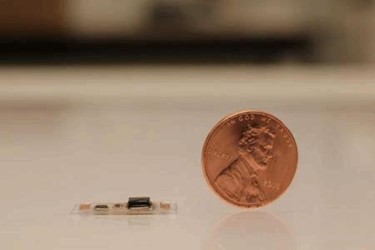"Tiny, Wearable Stethoscope" Monitors Human Heart Rate, Captures Human Speech

New wearable sensor technology uses acoustics to monitor a variety of vital signs, and is capable of recognizing human speech through the skin. Researchers from the University of Colorado, Boulder (CUB) and Northwestern University demonstrated that the device was light and flexible enough to be worn on the skin and can distinguish multiple physiological sounds.
Advances in mechano-acoustic signals and biosensing have presented a wide range of potential medical monitoring and fitness solutions, said authors of a study published in Science Advances. Researchers argued that existing monitoring devices — such as stethosocopes and digital accelerometers — could capture “some relevant data,” but had significant limitations in continuous wearablilty and “shortcomings associated with mechanical transduction of signals through skin.”
The team, co-led by Jae-Woong Jeong of CUB and John Rogers of Northwestern, proposed a design using a tiny acoustic sensor attached to sticky polymer that could conform to most surfaces on the body and allow for the evaporation of human sweat. The “low-density” device weighs less than one-hundredth of an ounce and is approximately the length of a U.S. penny, according to a press release.
In the study, researchers demonstrated the device’s ability to recognize the sound of heart valves opening and closing, record electromyogram (EMG) of contracting muscles, detect heart murmurs and blood clots, and recognize spoken words — all by recording and analyzing vibrations through the skin.
“The thin, soft, skin-like characteristics of these advanced wearable devices provide unique capabilities for ‘listening in’ to the intrinsic sounds of vital organs of the body, including the lungs and heart, with important consequences in continuous monitoring of physiological health,” said Rogers, who is the director of Northwestern Center for Bio-Integrated Electronics.
Jeong described the device as a “tiny, wearable stethoscope” and commented that the technology could be used for several human-machine interfaces in daily life. Jeong noted that the device could easily be wireless, and could be used to measure vital signs of patients remotely.
“Using the data from these sensors, a doctor at a hospital far away from a patient would be able to make a fast, accurate diagnosis,” said Jeong.
Researchers also demonstrated that the wearable device could recognize specific words and could be used to control other machines, such as video games. These functions, said Jeong, could assist patients with speech impairments to better communicate.
MIT scientists also have introduced an ingestible device that collects acoustic data on the device’s journey through the patient’s digestive system. Researchers believe the device could be a useful alternative to wearable, stick-on sensors that can be uncomfortable or unfeasible for trauma victims.
Apple recently filed a patent for a wearable device capable of recording electrocardiographic (EKG) signals from coordinated sensors placed at various points on the body and integrated into rings, brooches, and watches.
Tech giants inside and outside the medical industry are working to gain clinical edge for wearable health solutions, a market projected to be worth $41 billion by 2020.
